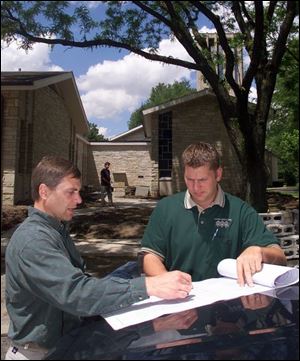
These professionals play vital roles in our green spaces
5/30/2001Landscape architects, landscape designers, and horticulturists all play important roles in our green spaces, but few gardeners can differentiate among them. Here's a quick look at each.
LANDSCAPE ARCHITECT
A landscape architect is like an attorney who must pass the bar exam before he or she can practice law.
Landscape architecture is the art and science of analysis, planning, design, management, preservation, and rehabilitation of land, according to the American Society of Landscape Architects. Landscape architects' expertise includes site planning, garden design, environments, restoration, land-use planning, and historic preservation.

Landscape designers Doug Bettinger, left, and Matt Kowalski of FloraLandscape look over plans for a project at Epworth United Methodist Church.
“We try to create a usable space for our clients,” says Tim Backbrader of Land Design, 126 West Front St., Perrysburg. “Usually it is on a large scale like roads, bridges, retaining walls, retention ponds, and wetlands.”
Public parks, parkways, corporate office buildings, management of large wilderness areas, and residential gardens are some typical projects for landscape architects.
They are required to take a two-day exam that covers liability issues, engineering, plant material, construction techniques, professional practice, and contracts.
Before taking the test, they are required to apprentice for two years under a landscape architect.
You can see some of Land Design's work in front of the Valentine Theatre in downtown Toledo, the Maumee River crossings and landings on both sides of the river, and planning and site development for the Mercy Children's Hospital.
“We do much more than residential landscape design. Usually we come up with the grand vision of what something will become and how a space will be used,” says Mr. Bockbrader, chairman of the American Society of Landscape Architects for the Maumee Valley section.
He says, “My favorite part of this job is seeing people use and enjoy the space as we intended when we designed it.”
LANDSCAPE DESIGNER
A landscape designer uses plant material to paint a beautiful and useful space. Depending on the designer's experience, the concept can be large or small.
Landscape designers are not required to have college degrees, and their training and experience can vary widely.
“A good designer has experience in horticulture, site analysis, soil conditions, and can fit plant material to fit a customer's setting,” says Doug Bettinger, chairman of the landscape design firm FloraLandscape, Inc., 130 Elmdale Rd.
According to the Ohio Nursery and Landscape Association, a professionally trained and experienced landscape designer can prepare a detailed landscape design. Landscape architects generally are needed when complex situations require design of extensive hardscapes such as sidewalks or roads, changes in drainage pat- terns and grades, and when other complex construction issues are to be included in a project.
Mr. Bettinger started FloraLandscape in 1979. He is on the board of directors for the Ohio Nursery and Landscape Association. “I enjoy the immediate gratification of growing something. Now as my company has grown, I enjoy developing people and helping them with their careers,” he says.
Designs that include many projects like outdoor cook centers, patios, and water gardens are some of their favorites. “It feels good to create an outdoor space that the whole family will use,” says Mr. Bettinger.
HORTICULTURALIST
A horticulturalist is the doctor of the gardening world. “We focus on the science of plants, fruits, diseases, and bugs,” says Amy Stone, Ohio State University horticulturalist. “Usually we are answering questions about problems that are popping up in the landscape. Many horticulturalists will specialize in different areas of crop science.”
Horticulturalists must have at least a bachelor's degree. Some pursue advanced degrees in specialized areas.
A horticulturalist is also a generalist, says Mr. Bettinger. “These scientists are usually out in the field helping growers with everyday problems.”
Ms. Stone is a Lucas County extension agent in charge of urban horticulture. She answers many questions about problems in the landscape from her office at Toledo Botanical Garden. She says knowing who to contact for a specific problem is a large part of her job. “Since we have studied the basic plant growth and development process, it helps us solve problems in many different applications.”
“I enjoy the variety in the things I do,” says Ms. Stone. “Every day there is something new to learn. It is very gratifying when I know that I have helped someone solve a mystery.”
All three professionals recommend plotting a strategy before you load your car with plants. A good design will keep your plants healthy and they will look spectacular as the years go by.
Kelly Heidbreder is The Blade's garden writer. E-mail her at getgrowingkelly@aol.com.